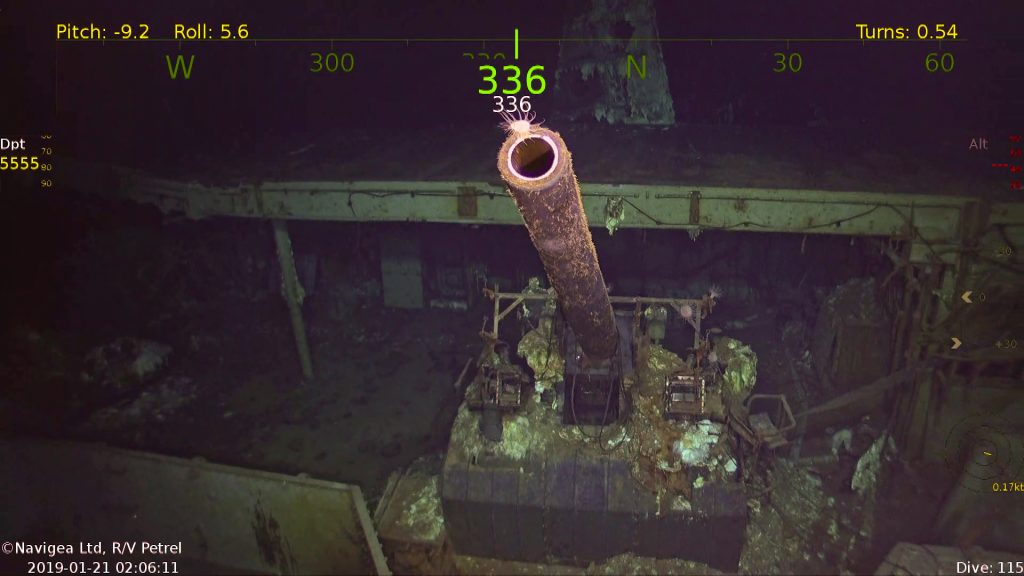Remains of USS Hornet, Storied WWII Aircraft Carrier, Discovered at Bottom of South Pacific

After a fierce battle in 1942, the USS Hornet succumbed to an onslaught from Japanese dive-bombers, torpedo planes and destroyers, which hit the ship with torpedoes. But now, after years of searching, shipwreck hunters have finally located the Hornet's remains at the bottom of the South Pacific.
In January, the 250-foot-long (76 meters) research vessel Petrel, owned by the late Paul Allen, who co-founded Microsoft with Bill Gates, found the wreckage near the Solomon Islands under about 17,490 feet (5,330 m) of water.
The USS Hornet was one of the most important aircraft carriers during World War II. It played key roles in the April 1942 Doolittle Raid against Tokyo and in the June 1942 Battle of Midway in the Pacific Ocean theater. But the Hornet met its end on Oct. 26, 1942, during the Battle of the Santa Cruz Islands. [Mayday! 17 Mysterious Shipwrecks You Can See on Google Earth]
When the Hornet sank, 140 sailors from a crew of nearly 2,200 lost their lives, according to the subsea operations team at Vulcan, the company Allen set up to manage his businesses and philanthropy.
The subsea operations team began their hunt for the missing aircraft carrier by scouring the official deck logs and action reports from the nine other U.S. warships that also fought in the Battle of the Santa Cruz Islands. After narrowing down the search area, the 10-person team used a deep-sea sonar drone that sent back a video feed from the seafloor and — amazingly — found the USS Hornet wreckage on its first try.
Then, the team confirmed the warship's identity by the hull classification symbol CV-8, which the drone spotted on the side of the sunken carrier.
For Richard Nowatzki, age 95, the memory of the USS Hornet is still fresh in his mind. Nowatzki was an 18-year-old gunner aboard the USS Hornet on its last mission.
Get the world’s most fascinating discoveries delivered straight to your inbox.
"When they left, we were dead in the water," Nowatzki told CBS News' Mark Phillips, referring to the Japanese fighters. "They used armor piercing bombs, now when they come down, you hear 'em going through the decks … plink, plink, plink, plink … and then when they explode the whole ship shakes."
Meanwhile, the expedition team said they were proud to find the ship's remains, and said its discovery was an homage to Allen, who died from complications related to non-Hodgkin lymphoma in December 2018.
"We had the Hornet on our list of WWII warships that we wanted to locate because of its place in history as a capital carrier that saw many pivotal moments in naval battles," Robert Kraft, director of subsea operations for Vulcan, said in the statement. "Paul Allen was particularly interested in aircraft carriers, so this was a discovery that honors his memory."
- Stunning Photos Capture Eerie Underwater Shipwrecks
- Shipwrecks Gallery: Secrets of the Deep
- WWII Shipwreck: Haunting Photos of the Battleship Musashi's Remains
Originally published on Live Science.

Laura is the managing editor at Live Science. She also runs the archaeology section and the Life's Little Mysteries series. Her work has appeared in The New York Times, Scholastic, Popular Science and Spectrum, a site on autism research. She has won multiple awards from the Society of Professional Journalists and the Washington Newspaper Publishers Association for her reporting at a weekly newspaper near Seattle. Laura holds a bachelor's degree in English literature and psychology from Washington University in St. Louis and a master's degree in science writing from NYU.




